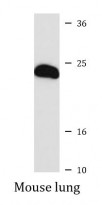ARG41289
anti-RGS16 antibody
anti-RGS16 antibody for IHC-Formalin-fixed paraffin-embedded sections,Western blot and Human,Mouse,Rat
Overview
| Product Description | Rabbit Polyclonal antibody recognizes RGS16 |
|---|---|
| Tested Reactivity | Hu, Ms, Rat |
| Tested Application | IHC-P, WB |
| Host | Rabbit |
| Clonality | Polyclonal |
| Isotype | IgG |
| Target Name | RGS16 |
| Antigen Species | Human |
| Immunogen | Recombinant fusion protein corresponding to aa. 1-202 of Human RGS16 (NP_002919.3). |
| Conjugation | Un-conjugated |
| Alternate Names | RGS16; RGS-r; Retinally abundant regulator of G-protein signaling; Retinal-specific RGS; A28-RGS14P; RGS-R; A28-RGS14; Regulator of G-protein signaling 16; hRGS-r |
Application Instructions
| Application Suggestion |
|
||||||
|---|---|---|---|---|---|---|---|
| Application Note | * The dilutions indicate recommended starting dilutions and the optimal dilutions or concentrations should be determined by the scientist. | ||||||
| Positive Control | Mouse lung | ||||||
| Observed Size | 28 kDa |
Properties
| Form | Liquid |
|---|---|
| Purification | Affinity purified. |
| Buffer | PBS (pH 7.3), 0.02% Sodium azide and 50% Glycerol. |
| Preservative | 0.02% Sodium azide |
| Stabilizer | 50% Glycerol |
| Storage Instruction | For continuous use, store undiluted antibody at 2-8°C for up to a week. For long-term storage, aliquot and store at -20°C. Storage in frost free freezers is not recommended. Avoid repeated freeze/thaw cycles. Suggest spin the vial prior to opening. The antibody solution should be gently mixed before use. |
| Note | For laboratory research only, not for drug, diagnostic or other use. |
Bioinformation
| Database Links |
Swiss-port # O15492 Human Regulator of G-protein signaling 16 Swiss-port # P97428 Mouse Regulator of G-protein signaling 16 |
|---|---|
| Gene Symbol | RGS16 |
| Gene Full Name | regulator of G-protein signaling 16 |
| Background | The protein encoded by this gene belongs to the 'regulator of G protein signaling' family. It inhibits signal transduction by increasing the GTPase activity of G protein alpha subunits. It also may play a role in regulating the kinetics of signaling in the phototransduction cascade. [provided by RefSeq, Jul 2008] |
| Function | Inhibits signal transduction by increasing the GTPase activity of G protein alpha subunits thereby driving them into their inactive GDP-bound form. Binds to G(i)-alpha and G(o)-alpha, but not to G(s)-alpha. May play a role in regulating the kinetics of signaling in the phototransduction cascade. [UniProt] |
| Cellular Localization | Membrane; Lipid-anchor. [UniProt] |
| Calculated MW | 23 kDa |
| PTM | Palmitoylated on Cys-2 and/or Cys-12. Phosphorylated. Phosphorylation at Tyr-168 by EGFR enhances GTPase accelerating (GAP) activity toward GNAI1. [UniProt] |
Images (1) Click the Picture to Zoom In






